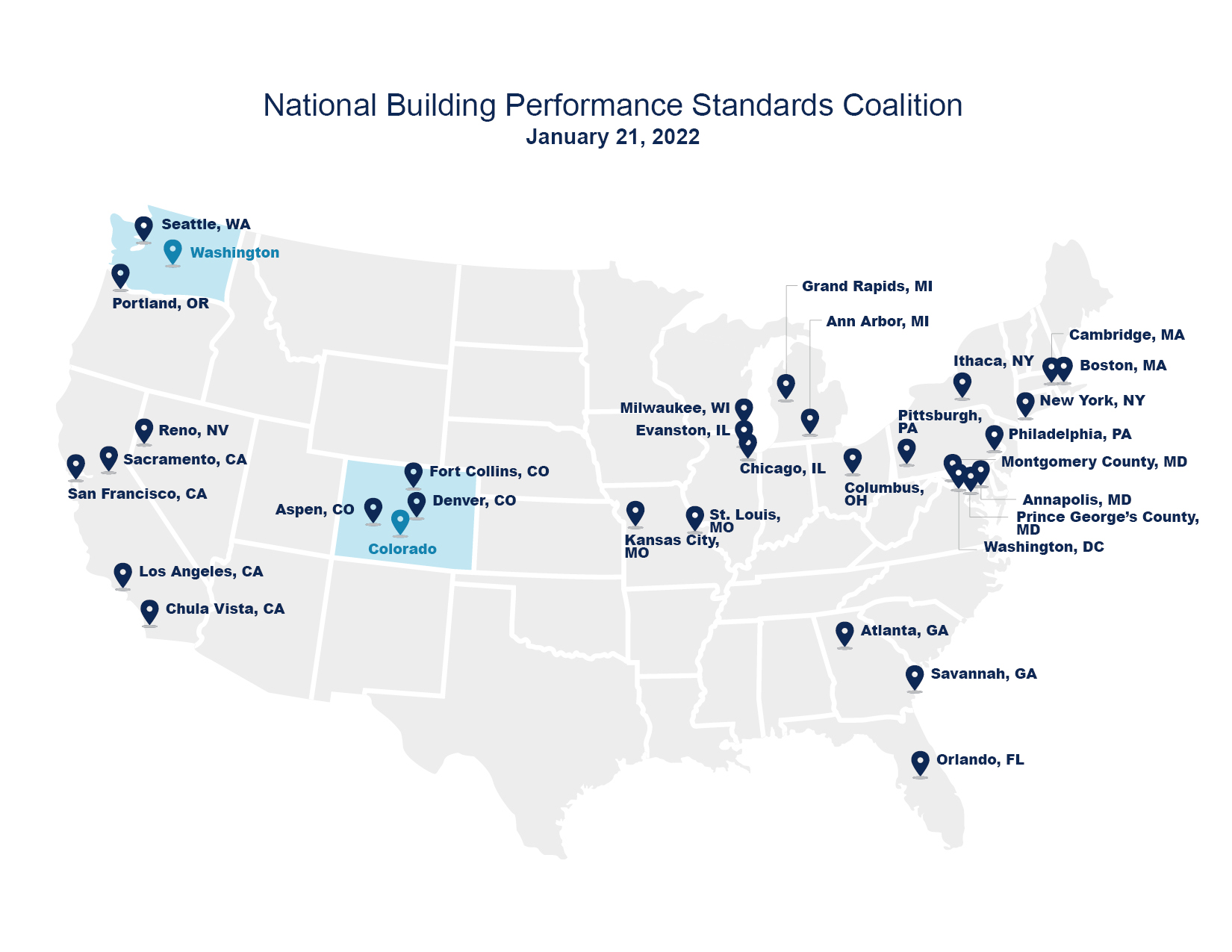
A quiet revolution is underway in the building industry. For decades, our industry has evaluated the performance of buildings based on technical standards developed by national organizations, such ASHRAE 90.1 energy codes. These standards are designed to achieve a variety of goals, such as operational cost saving. They are explicitly not designed to address or support local needs or policy goals, critically including greenhouse gas emissions reduction.
Today, we are seeing a shift toward a new generation of building performance standards set by local governments and sometimes even private organizations. Many of these new standards are directly linked to local decarbonization pathways. These new tools are explicitly designed to drive targeted improvements in local building stocks. In other words, they are not interested in beating ASHRAE’s definition of cost-effectiveness or shifting the overall US building stock. Rather, they want to drive specific changes in targeted buildings in Seattle, Denver, Washington, DC, or dozens of other jurisdictions.
These aspirations are reflected in the National Building Performance Standards Coalition, officially announced by the Biden Administration on January 21, 2022.

The Coalition members are pursuing a wide-range of efforts to understand and improve building performance. Broadly speaking, the participants share an emphasis on transparency, performance benchmarking, and the intention to increase the stringency of performance targets over time. These shared values are complemented by a fundamental appreciation for the benefits of diverse, place-based policy designs.
The take home is clear and revolutionary: The definition of high performance is shifting from “top down” tools to “bottom up” standards aligned with local needs and conditions. The focus for standards is also moving from the aspirations of design to more tangible measured performance outcomes.
This transformation is a good thing. This is a moment for local governments to lead and demand that buildings in their communities meet local needs and expectations. This approach will underpin the next generation of green building practice, creating disruption and challenges. By design, location-based BPS requirements will change from jurisdiction-to-jurisdiction, reflecting real differences between communities. This will make the world more complex, as well as more representative and responsive. Over time, we can find a balance that recognizes the need for location-based decarbonization trajectories and provides a degree of consistency in approaches and metrics.
Arc provides practical tools to support this revolution. This starts with a fundamental recognition that there are many ways to interpret the same building performance data. In other words, the same performance means different things in different places at different times. This is a feature, not a bug. Arc embraces this through its Advanced Scoring module – available in Project Tools for all Arc Essentials users.
Advanced Scoring compares project performance – typically energy and/or greenhouse gas emissions – to a growing library of Building Performance Standards. The standards serve a variety of purposes, for example:
- Arc Performance Score compares projects to a reference set of LEED-certified green buildings.
- ENERGY STAR compares projects to the U.S. building stock as represented in the CBECS database.
- CRREM compares projects to national decarbonization pathways for selected countries in Europe and Asia.
- ASHRAE 100 provides an energy intensity benchmark stratified by property type and climate zone.
- GRESB provides a global reference point for the median energy intensity among 2020 and 2021 investor-owned companies and funds.
- A growing list of local performance standards, including New York, Boston, Washington, DC, Chicago, and many more.
These capabilities can be used by local governments and private organizations to create, operate, and enhance building performance programs. This often includes the following four steps:
- Standard development
- Performance evaluation
- Performance communication
- Support and celebration
Step #1 Standard Development
The heart of the National Building Performance Standards Coalition is the development of aggressive local targets for building performance. This is rooted in the need for place-based policies linked to community-specific decarbonization roadmaps. Arc can help local governments understand this rapidly evolving policy landscape and identify frameworks that can be adapted or customized to meet their circumstances. Right now, local governments can consider three different types of standards, including:
- Single point thresholds, e.g., the District of Columbia Building Energy Performance Standard
- Multi-year trajectories, e.g., Boston’s Building Energy Reporting and Disclosure Ordinance
- Improvement, e.g., the Green Sports Alliance Play to Zero program
Arc Advanced Scoring supports all of these structures within a common, shareable framework. We can share examples and help local governments and organizations create their own standards.
Step #2 Performance Evaluation
Once a standard is established, jurisdictions need to provide tools to evaluate performance and meet compliance requirements. For many jurisdictions, this can leverage the U.S. Environmental Protection Agency’s ENERGY STAR Portfolio Manager (ESPM). This provides a familiar data management system for energy and water, sometimes providing direct connections to utility data. Right now, ESPM works best for threshold-type standards focused on source energy or ENERGY STAR scores, such as Washington, DC and Seattle.
Some jurisdictions may want to create more advanced standards, such as those based on multi-year trajectories or facility-level improvement, e.g., Boston’s Building Energy Reporting and Disclosure Ordinance (BERDO). Arc Advanced Scoring supports both of these BPS types, while also supporting comparison with a wide variety of local, national, and international standards. Arc also reads data directly from ESPM and other data partners. This makes it easy to start with ESPM and develop more advanced performance pathways.
Step #3 Performance Communication
The next step is to communicate performance. This requires several interconnected functions, including data quality checks, reporting period selection, and summary of key performance metrics. Arc provides these functions, along with multiple options for sharing them publicly and privately, including
- Private performance dashboards
- Periodic team emails
- Embeddable widgets
- Comprehensive PDF reports, and
- Excel exports.
These tools are available for single facilities and aggregated across entire portfolios (e.g., groups of participants).
Step #4 Support and Celebration
Every BPS program needs a standard, compliance mechanism, and reporting function. Effective BPS programs complement these core functions with activities to encourage performance improvement and celebrate leadership. This is where Arc shines.
Conclusion
The BPS revolution is a turning point for the building industry. Over time, it will help encourage the industry to deliver real world performance against locally-relevant performance targets. The benefits of the BPS revolution will require local governments and organizations to develop more sophisticated and targeted performance goals. In turn, developers and operators will need to create roadmaps to achieve these targets, along with establishing the processes needed to benchmark, track, and communicate performance over time. Arc can help both groups. Governments and organizations can use Arc to create and share everything from simple thresholds to complex decarbonization trajectories. Arc can help space, building, and portfolio managers evaluate these requirements and improve over time.
The Arc team is ready to help jurisdictions and managers work through any or all of these steps. Reach out to us to learn more: contact@arcskoru.com
